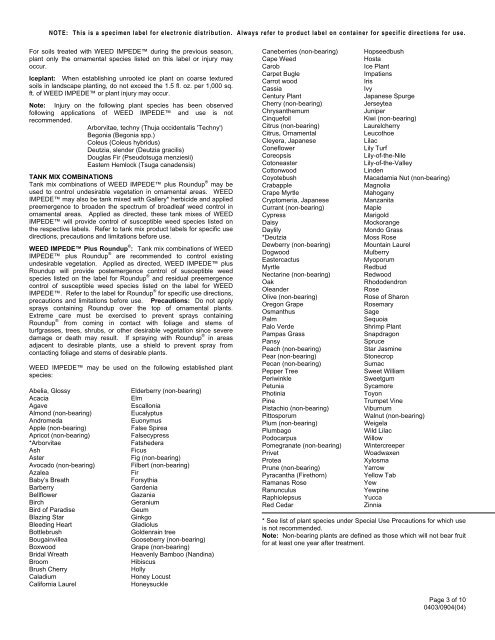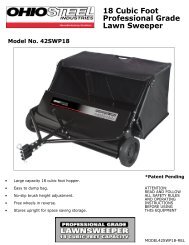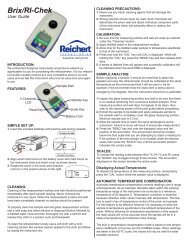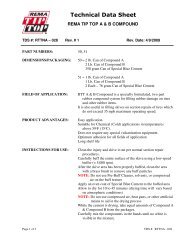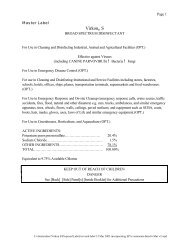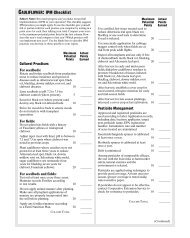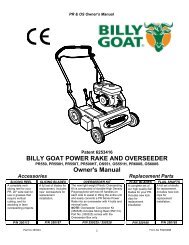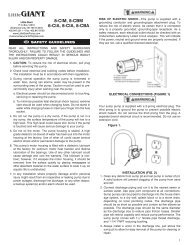WEED IMPEDE™ - Do My Own Pest Control
WEED IMPEDE™ - Do My Own Pest Control
WEED IMPEDE™ - Do My Own Pest Control
Create successful ePaper yourself
Turn your PDF publications into a flip-book with our unique Google optimized e-Paper software.
NOTE: This is a specimen label for electronic distribution. Always refer to product label on container for specific directions for use.<br />
For soils treated with <strong>WEED</strong> IMPEDE during the previous season,<br />
plant only the ornamental species listed on this label or injury may<br />
occur.<br />
Iceplant: When establishing unrooted ice plant on coarse textured<br />
soils in landscape planting, do not exceed the 1.5 fl. oz. per 1,000 sq.<br />
ft. of <strong>WEED</strong> IMPEDE or plant injury may occur.<br />
Note: Injury on the following plant species has been observed<br />
following applications of <strong>WEED</strong> IMPEDE and use is not<br />
recommended.<br />
Arborvitae, techny (Thuja occidentalis 'Techny')<br />
Begonia (Begonia spp.)<br />
Coleus (Coleus hybridus)<br />
Deutzia, slender (Deutzia gracilis)<br />
<strong>Do</strong>uglas Fir (Pseudotsuga menziesii)<br />
Eastern Hemlock (Tsuga canadensis)<br />
TANK MIX COMBINATIONS<br />
Tank mix combinations of <strong>WEED</strong> IMPEDE plus Roundup ® may be<br />
used to control undesirable vegetation in ornamental areas. <strong>WEED</strong><br />
IMPEDE may also be tank mixed with Gallery* herbicide and applied<br />
preemergence to broaden the spectrum of broadleaf weed control in<br />
ornamental areas. Applied as directed, these tank mixes of <strong>WEED</strong><br />
IMPEDE will provide control of susceptible weed species listed on<br />
the respective labels. Refer to tank mix product labels for specific use<br />
directions, precautions and limitations before use.<br />
<strong>WEED</strong> IMPEDE Plus Roundup ® : Tank mix combinations of <strong>WEED</strong><br />
IMPEDE plus Roundup ®<br />
are recommended to control existing<br />
undesirable vegetation. Applied as directed, <strong>WEED</strong> IMPEDE plus<br />
Roundup will provide postemergence control of susceptible weed<br />
species listed on the label for Roundup ® and residual preemergence<br />
control of susceptible weed species listed on the label for <strong>WEED</strong><br />
IMPEDE. Refer to the label for Roundup ® for specific use directions,<br />
precautions and limitations before use. Precautions: <strong>Do</strong> not apply<br />
sprays containing Roundup over the top of ornamental plants.<br />
Extreme care must be exercised to prevent sprays containing<br />
Roundup ®<br />
from coming in contact with foliage and stems of<br />
turfgrasses, trees, shrubs, or other desirable vegetation since severe<br />
damage or death may result. If spraying with Roundup ®<br />
in areas<br />
adjacent to desirable plants, use a shield to prevent spray from<br />
contacting foliage and stems of desirable plants.<br />
<strong>WEED</strong> IMPEDE may be used on the following established plant<br />
species:<br />
Abelia, Glossy<br />
Acacia<br />
Agave<br />
Almond (non-bearing)<br />
Andromeda<br />
Apple (non-bearing)<br />
Apricot (non-bearing)<br />
*Arborvitae<br />
Ash<br />
Aster<br />
Avocado (non-bearing)<br />
Azalea<br />
Baby’s Breath<br />
Barberry<br />
Bellflower<br />
Birch<br />
Bird of Paradise<br />
Blazing Star<br />
Bleeding Heart<br />
Bottlebrush<br />
Bougainvillea<br />
Boxwood<br />
Bridal Wreath<br />
Broom<br />
Brush Cherry<br />
Caladium<br />
California Laurel<br />
Elderberry (non-bearing)<br />
Elm<br />
Escallonia<br />
Eucalyptus<br />
Euonymus<br />
False Spirea<br />
Falsecypress<br />
Fatshedera<br />
Ficus<br />
Fig (non-bearing)<br />
Filbert (non-bearing)<br />
Fir<br />
Forsythia<br />
Gardenia<br />
Gazania<br />
Geranium<br />
Geum<br />
Ginkgo<br />
Gladiolus<br />
Goldenrain tree<br />
Gooseberry (non-bearing)<br />
Grape (non-bearing)<br />
Heavenly Bamboo (Nandina)<br />
Hibiscus<br />
Holly<br />
Honey Locust<br />
Honeysuckle<br />
Caneberries (non-bearing)<br />
Cape Weed<br />
Carob<br />
Carpet Bugle<br />
Carrot wood<br />
Cassia<br />
Century Plant<br />
Cherry (non-bearing)<br />
Chrysanthemum<br />
Cinquefoil<br />
Citrus (non-bearing)<br />
Citrus, Ornamental<br />
Cleyera, Japanese<br />
Coneflower<br />
Coreopsis<br />
Cotoneaster<br />
Cottonwood<br />
Coyotebush<br />
Crabapple<br />
Crape <strong>My</strong>rtle<br />
Cryptomeria, Japanese<br />
Currant (non-bearing)<br />
Cypress<br />
Daisy<br />
Daylily<br />
*Deutzia<br />
Dewberry (non-bearing)<br />
<strong>Do</strong>gwood<br />
Eastercactus<br />
<strong>My</strong>rtle<br />
Nectarine (non-bearing)<br />
Oak<br />
Oleander<br />
Olive (non-bearing)<br />
Oregon Grape<br />
Osmanthus<br />
Palm<br />
Palo Verde<br />
Pampas Grass<br />
Pansy<br />
Peach (non-bearing)<br />
Pear (non-bearing)<br />
Pecan (non-bearing)<br />
Pepper Tree<br />
Periwinkle<br />
Petunia<br />
Photinia<br />
Pine<br />
Pistachio (non-bearing)<br />
Pittosporum<br />
Plum (non-bearing)<br />
Plumbago<br />
Podocarpus<br />
Pomegranate (non-bearing)<br />
Privet<br />
Protea<br />
Prune (non-bearing)<br />
Pyracantha (Firethorn)<br />
Ramanas Rose<br />
Ranunculus<br />
Raphiolepsus<br />
Red Cedar<br />
Hopseedbush<br />
Hosta<br />
Ice Plant<br />
Impatiens<br />
Iris<br />
Ivy<br />
Japanese Spurge<br />
Jerseytea<br />
Juniper<br />
Kiwi (non-bearing)<br />
Laurelcherry<br />
Leucothoe<br />
Lilac<br />
Lily Turf<br />
Lily-of-the-Nile<br />
Lily-of-the-Valley<br />
Linden<br />
Macadamia Nut (non-bearing)<br />
Magnolia<br />
Mahogany<br />
Manzanita<br />
Maple<br />
Marigold<br />
Mockorange<br />
Mondo Grass<br />
Moss Rose<br />
Mountain Laurel<br />
Mulberry<br />
<strong>My</strong>oporum<br />
Redbud<br />
Redwood<br />
Rhododendron<br />
Rose<br />
Rose of Sharon<br />
Rosemary<br />
Sage<br />
Sequoia<br />
Shrimp Plant<br />
Snapdragon<br />
Spruce<br />
Star Jasmine<br />
Stonecrop<br />
Sumac<br />
Sweet William<br />
Sweetgum<br />
Sycamore<br />
Toyon<br />
Trumpet Vine<br />
Viburnum<br />
Walnut (non-bearing)<br />
Weigela<br />
Wild Lilac<br />
Willow<br />
Wintercreeper<br />
Woadwaxen<br />
Xylosma<br />
Yarrow<br />
Yellow Tab<br />
Yew<br />
Yewpine<br />
Yucca<br />
Zinnia<br />
* See list of plant species under Special Use Precautions for which use<br />
is not recommended.<br />
Note: Non-bearing plants are defined as those which will not bear fruit<br />
for at least one year after treatment.<br />
Page 3 of 10<br />
0403/0904(04)


